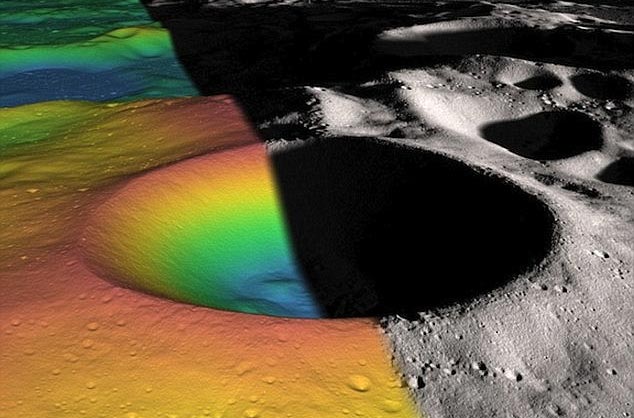NASA wants to turn the Moon into a robot lab
The US Aerospace Agency (NASA) is planning to turn a pit on the Moon into a science laboratory for robots.
Turn the Moon into a robot lab
According to NASA, the Shackleton pit on the south pole of the moon could be turned into "a warm oasis of sunlight, surrounded by a frosty dark desert at a frozen level".

NASA wants to use the Japanese glasses to illuminate and heat the Shackleton hole on the moon to turn it into a science laboratory for robots.(Artwork: NASA)
The experiment of creating terrain using self-propelled machines will make the moon's environment more similar to Earth and allow robots to work inside it to analyze materials brought about after digging. . The area chosen as the "laboratory " will be about the size of a football field, located in a valley that is twice the size of Washington, the US capital.
NASA plans to bring solar- powered transformers into the Shackleton pit , in order to provide essential power for robot scientists as well as for heating. According to experts, in the dark, this moon hole has a temperature of about -173 ° C, but a series of solar reflectors or regular glass, can illuminate and warm up space.
"From a low angle on the horizon, the rays of the sun never shine through the peaks of the valley, until the fixed glasses are installed on these peaks and re-regulate the sun's rays down to form an oasis of sunshine This place will become a large science laboratory and a place to produce hydrogen and liquid oxygen, providing fuel for the largest planetary journeys outside the Earth. " Expert Adrian Stoica from NASA's Jet Motion Laboratory in Pasadena, California, explained.
The reflectors will be carried by self-propelled machines throughout the Shackleton crater, so that they can be spread out when needed and used to shine sunlight into the hole. A single glass, with a diameter of 40 meters, can reflect light to power a fleet of self-propelled Curiosity vehicles 10km away from it to prevent them from freezing.
Stoica further explained that such topographic systems are capable of directing energy into extreme harsh environments, such as Shackleton pits, and transforming them into mild , suitable microenvironments . suitable for robots and even people who reside and work.
The plan has been included in NASA's Phase 2 funding proposal, requiring $ 500,000 for two-year research, according to PopScience.
The next step is to design a folding glass that folds into a cube of 1 meter in size on each side and weighs less than 100kg. Such a structure will spread over 3,261 meters.
- Scientists are angry because NASA canceled the mission to bring robots to the Moon
- Space explorer robot
- Moon exploration robot
- China plans to build a robot station on the Moon
- Robot astronaut: NASA's M Plan
- After the moon is Mars
- German robots will explore the Moon
- NASA revealed the time of the first immigration settlement on the Moon
- Moon robot rolling test on volcanic slopes
- NASA humanoid rescue robot
- Hearing that Russia will go to the Moon to check, NASA rushes to prepare to send people to the Moon again
- China farewell the Moon exploration robot
 Van Allen's belt and evidence that the Apollo 11 mission to the Moon was myth
Van Allen's belt and evidence that the Apollo 11 mission to the Moon was myth The levels of civilization in the universe (Kardashev scale)
The levels of civilization in the universe (Kardashev scale) Today Mars, the sun and the Earth are aligned
Today Mars, the sun and the Earth are aligned The Amazon owner announced a secret plan to build a space base for thousands of people
The Amazon owner announced a secret plan to build a space base for thousands of people